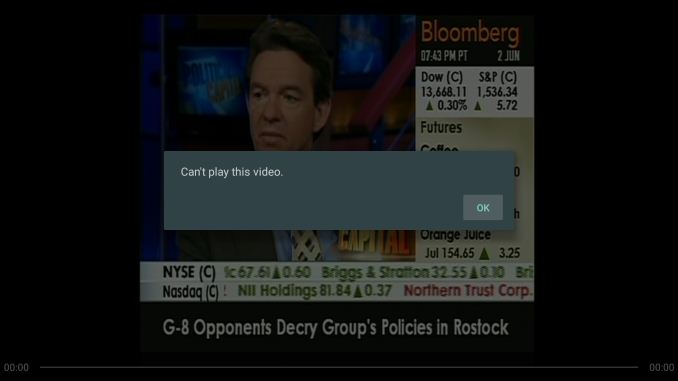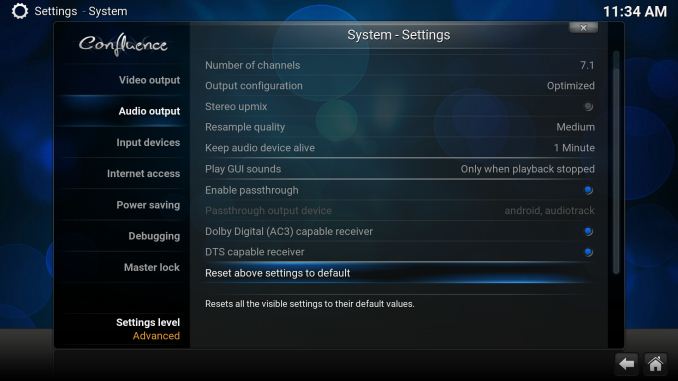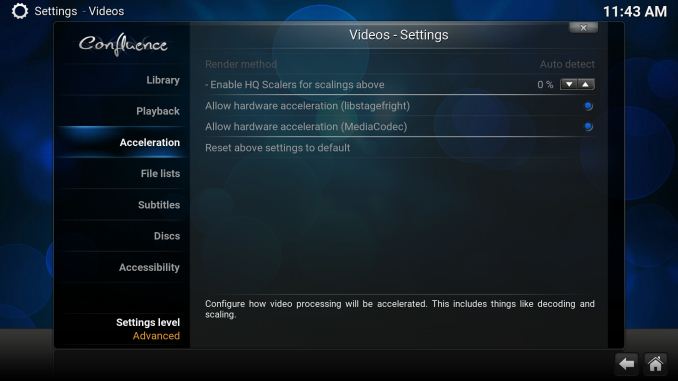The NVIDIA SHIELD Android TV Review: A Premium 4K Set Top Box
by Ganesh T S on May 28, 2015 3:00 PM EST- Posted in
- Media Streamer
- Home Theater
- TV
- 4K
- Shield
- NVIDIA
Local Media Playback Evaluation
The announcement of the SHIELD Android TV box generated a lot of interest amongst media streaming enthusiasts. It has continued to this date. Given that most of them prefer local media playback to OTT streaming, there has been marked interest in the local media playback capabilities of the unit. In this section, we attempt to set the expectations right on the various relevant aspects.
Display Refresh Rate
The Android TV framework forces the interface and most apps to run at 60 Hz. Obviously, a 24 fps film needs to be pulled-down with a 3:2 cadence to let the display be refreshed at 60 Hz. This creates a judder effect. Apps such as TVHZ were created to resolve this issue, but needs manual intervention prior to media playback. Kodi's currently existing 'sync refresh rate to playback frame rate' option doesn't work, but a fix is probably coming soon.
Codecs Licensing
Unlike a PC, the SHIELD Android TV is an embedded system. Therefore, codec support involves NVIDIA signing licensing deals. For example, support for Dolby Digital / Dolby Digital Plus requires deals with Dolby Laboratories, while DTS / DTS-HD support requires deals with DTS. On the video side, H.264 support, for example, requires a deal with MPEG-LA. Each of these deals ends up increasing the end cost for the consumer. In order to hit an acceptable price point while ensuring all necessary components for OTT streaming (SHIELD's primary market) are in place, NVIDIA has signed deals for the following audio/video codecs only:
- H.264
- H.265
- VP9
- Dolby Digital (Update: only bitstreaming, no internal decode to PCM)
- Dolby Digital Plus (Update: only bitstreaming, no internal decode to PCM)
This means that the native Android Video Player can only play back the above codecs (in addition to the free-to-decode / play ones such as PCM audio). This also means that the SHIELD Android TV will not be doing any HD audio bitstreaming in the near future unless things chance on the licensing front.
That said, players such as Kodi, MX Player etc. can opt to use pure software decoding when hardware decoding is not available. It is also possible for app vendors to purchase the license themselves and then work with NVIDIA to get hardware acceleration / support for that. For example, SiliconDust (the vendor behind HDHomeRun) is doing it with their Live TV app in order to get hardware decoding enabled for MPEG-2.
Attempting 480i60 MPEG-2 Playback with the Native Android Video Player
Video Post Processing
Deinterlacing and pull-down detection / IVTC are essential for watching certain live TV channels and other interlaced content. NVIDIA only guarantees video post processing for the licensed codecs that go through their hardwrae decoder. Third-party players will need to work with NVIDIA to ensure that any software decoded streams are correctly hooked up to the post-processing chain.
We tried processing the HQV Benchmark videos on the SHIELD to get an objective evaluation of the SHIELD's post-processing capabilities, but unfortunately the MPEG-2 encoded streams were not processed properly when decoded in software on Kodi.
Experimenting with Kodi
The Kodi 15.0 beta 1 APK is available for sideloading on to the SHIELD Android TV. On the bitstreaming side, we could only select DTS and Dolby Digital, and Kodi had no problems bitstreaming those streams.
We played back our test streams from a Samsung T1 portable SSD attached to the USB 3.0 port. HEVC streams played back with hardware acceleration inside the Kodi interface, but Kodi had trouble with TS files. For hardware-accelerated codecs, the power consumption at the wall was around 6 W. For software-decoded ones such as our 1080i60 VC-1 clip, the power consumption shot up to 11.5 W.
The SHIELD Android TV / Kodi combination has absolutely no trouble with the vanilla H.264 files that people usually rip their Blu-rays to. Fortunately, despite the lack of MPEG-2 and VC-1 licenses, Kodi's software decode is efficient enough to not cause frame drops. The absence of deinterlacing is an issue, but that should hopefully get resolved soon.
Based on our evaluation, the SHIELD Android TV is definitely not a comprehensive HTPC replacement - particularly from the local media playback viewpoint. That said, it does have support for all major OTT services and Live TV as well as future DVR capabilities (thanks to Android TV). For a certain set of users, it is possible that the SHIELD can replace their HTPC. However, one needs to remember that the unit is an embedded system with plenty of constraints and doesn't have the same openness and flexibility that a HTPC has to offer.













167 Comments
View All Comments
spinportal - Thursday, May 28, 2015 - link
What is interesting is comparing to the Intel NUCs for a media center hub (or HP Stream Mini) with Windows 10. The CPU power is close to the Intel Celeron 2957U, where a i5-5250U (NUC5i5YH/R) is 50% faster, but the Intel HD graphics is probably 20% slower. Both are fighting for the 4K home theater crowd, but Shield TV is cheaper (barebone NUC is 399 extra SDRAM & mSATA & remote/controller) and baked in 10' UI/UX and easier to maintain for the average user with support for DVR in the future and GRID gaming. Sure Win 10 will have a 10' UI and you can install whatever you want on it to customize to your own content, but higher price to entry and more time needed to tweak. The Intel Stick is cute at $150, but falls short in competition for the checklist of features. If sideloading is easy on the Shield TV, tweakers can rejoice and hope apps will scale properly. If people have an XB1 and enjoy the media apps / services and voice activation, then it's a hard sell. Gamestream is just icing, helping the portability of the Shield TV in a remote location (at home most games would have a big enough screen connected and avoid input lag). It's not a Roku or a Chromecast, so to get customers to make a premium purchase like this, targeting 4K video is the bait.nathanddrews - Thursday, May 28, 2015 - link
"This also means that the SHIELD Android TV will not be doing any HD audio bitstreaming"Stopped reading.
Sivar - Thursday, May 28, 2015 - link
``Consumers need to get their expectations right - the SHIELD Android TV needs consideration only if OTT streaming (4K Netflix, in particular) and gaming credentials are important.''The key feature I need is HEVC compatibility. I have many Blu-rays that I encode with FLAC audio, but with my FireTV, I am unable to use HEVC.
Are you saying that the Shield Android-TV is a poor choice for my requirements?
ganeshts - Thursday, May 28, 2015 - link
If you are savvy enough to encode your Blu-rays with HEVC, then I am sure you understand what I am trying to convey..The typical media library also includes TV programs that are interlaced MPEG-2 (for example). The SHIELD is currently not a good solution for such a case.
I have outlined clearly what works and what doesn't. In your case, I would still suggest waiting for a proper HTPC with HDMI 2.0 / HEVC support unless HEVC-encoded Blu-ray rips are the only media files you plan to play in your setup.
TheJian - Friday, May 29, 2015 - link
Being savvy enough to check a few boxes doesn't mean you know everything about formats. You can muddle through handbrake without doing much more than selecting a profile for your device. The person states they are wanting FLAC+HEVC yet you tell him wait for HTPC. HE was clear in what he needed, so you should just say yes it plays what you need, or no it doesn't instead of a flippant response :( He likely has other players for other formats already hence his main feature desired is what he inquired about.But still you're acting as if mpeg2 interlaced is all anyone wants and a reason to NOT buy it, when I'd suggest it's not many people (that can’t get that some other way until this unit CAN do it, like a dvd player or bluray player in your rack already) and most would want all the other stuff this thing can play NOT just bluray HEVC encoded stuff. IE, anything in mkv/mp4 with dolby etc in h264/x264 (which is most libraries of current content and mostly what people rip bluray to also as you even note in the review). This thing plays a LOT more than hevc. IF you're only going to use the NATIVE Android Tv player then it's somewhat limited, but you're not stuck with that and can choose a dozen or more others (paid or free). 3rd party stuff can easily be had to get around it all if not now then at some point most likely. IE you mention kodi can play mpeg2 without license in software. You also mention Deinterlacing might be added soon to Kodi. So your problem with the device here just a software fix away anyway (and only the interlaced part is a problem correct?)? There are many free apps that can deinterlace already on PC for conversion even if players that do it on android don’t exist…but wait for it…
Just check googleplay store: BSplayer, MX player Pro, KMplayer, vlc, etc (not saying which does the job just noting a bunch):
https://www.youtube.com/watch?v=HSBG13gknoA
1080i mpeg 2 on mxplayer without transcoding. Appears this would solve your combo problem, and this is really old version of the software from 2013 post running on nexus 2013. I’m thinking your excuse for not buying is dead already. You can use de-interlacing option in MX player > settings > decoder. Considering you MENTIONED MX Player in your review, you can’t be this ignorant right or am I missing something? Unlike the OP who may NOT know about all this stuff, you definitely DO know about MX player yet seem to be unable to pass the chance to find some reason to KNOCK an nvidia product even when you know what I just showed fixes it. Typical Anandtech BIAS against Nvidia stuff (**cough AMD portal cough**) here or what?
From your last sentence it almost seems as you're acting like HEVC encoded blurays is all it does, which is categorically false (even though that is what the guy said he wanted to play as a main feature).
Worse you even state most people do the following (which it plays fine):
"The SHIELD Android TV / Kodi combination has absolutely no trouble with the vanilla H.264 files that people usually rip their Blu-rays to."
But no ignore that, it doesn't play mpeg2 interlaced stuff (yet, at least out of the box, but seems to with at least mxplayer as shown which you know about) so it sucks...LOL. OK...Whatever. With 100million-500million installs I think most know about this app (free with ads, $6 without) yet you avoid using it for testing. 2.8million reviews too...LOL. That has to be one of the MOST KNOWN apps on android as most use videos on mobile. How well it works on a TV who knows (10 foot interface? Not sure) but that isn't the point. Worst case you just use it for specific vids with issues. .ts files play fine on mx player also. It seems to have many multiples of the installs of kodi (or xbmc if you like). Kodi on the other hand is only available to the handful of people that can find it (not directly on googleplay so to speak).
http://www.androidpolice.com/2015/04/03/kodi-forme...
You can follow how to get to it above I guess if desired (from googleplay & not sideloaded). Maybe this will help it gain popularity ;)
http://forum.kodi.tv/showthread.php?tid=160720&...
Instructions here too I guess.
MX Player features (among other stuff):
"Plays almost every movie files including .3gp .avi .divx .f4v .flv .mkv .mp4 .mpeg .mov .vob .wmv .webm .xvid and many more."
Either I'm missing something here, or don't really get the complaints you're making nor your flippant response to the OP. Are you saying MX Player with deinterlacing checked won't work for mpeg2 as shown in the supplied youtube video? That guy is testing 1080i mpeg2 on it. I'm confused.
Adding-Color - Thursday, May 28, 2015 - link
My ibothsion is that it will play hevc/h.265 content with hardware acceleration and flac should have no licensing issues and doesn't need hardware acceleration, software acceleration should very well be possible on such a beefy SOC. I don't know if there's yet a software avaible that combines both though.Adding-Color - Thursday, May 28, 2015 - link
My impression ...Aegrum - Thursday, May 28, 2015 - link
Perhaps I missed it, but to me the killer feature is streaming my steam library to my TV from my GTX 680 desktop. Why didn't you cover that? I couldn't care less about the android games. Being able to plop down on my couch and stream Witcher 3 from my PC is worth the price of admission, as it nullifies any desire for a steambox, if it works well.jjj - Thursday, May 28, 2015 - link
The 50$ Sream Link should do that in a few months. If it works well enough , getting this just for that feature is excessive.Aegrum - Friday, May 29, 2015 - link
Sadly that price doesn't include the Steam controller, which is likely to be at least $50. I'm also in need of a streaming device for the television, so while yes, a steam link + controller + chromecast would be ~$135, I think the extra capabilities of this device for $200 is a fair price. Plus it's 4K ready for once I get a 4K TV, and all on one HDMI input that I don't have to switch between. And plays more than just what I have in Steam, though unconfirmed whether Steam link will play non-steam titles or not.I like the Steam link, especially for the price, but for me I think the Shield console is a better fit.